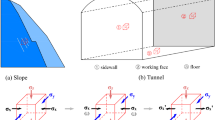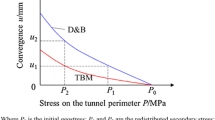Abstract
Underground chambers and tunnels in different strata have different failure modes. In practice, stability evaluation of underground engineering should consider the surrounding rock creep properties. In this research, uniaxial and triaxial creep tests are performed to explore the mechanical and fracture behaviors of mudstone, sandstone, and limestone. The experimental results show that the fissure angle (α) has a great effect on the long-term strength (LTS) of sandstone and limestone, and their minimum values are observed when α = 75° and 45°, which are 26.7% and 25% lower than those of the corresponding intact samples, respectively. However, the fluctuation in the LTS of mudstone is less than 5.2%. The steady creep strain rate of fissured mudstone does not increase as significantly as that of sandstone and limestone, which increase more than 6 times when the deviatoric stress exceeds the LTS. As α increases, the failure modes of mudstone and sandstone change from mixed failure to tensile failure when α = 75°, and limestone samples mainly exhibit tensile failure. Limestone and sandstone are prone to shear failure under confining pressure and have higher degrees of internal crack development than mudstone. The dissipated energy of limestone is higher than that of sandstone and mudstone. A high dissipated energy ratio is closely related to a low LTS and tensile failure. Due to the small variation in the LTS of fissured mudstone, using LTS to judge stability is effective. For sandstone and limestone, the sudden increase in the steady creep strain rate can be an indicator for evaluating stability.

















Similar content being viewed by others
Data availability
The raw/processed data required to reproduce these findings cannot be shared at this time as the data also forms part of an ongoing study.
References
Atkinson BK (1984) Subcritical crack growth in geological materials. J Geophys Red-Sol Ea 89:4077–4114. https://doi.org/10.1029/JB089iB06p04077
Bobet A, Einstein HH (1998) Fracture coalescence in rock-type materials under uniaxial and biaxial compression. Int J Rock Mech Min 35:863–888. https://doi.org/10.1016/S0148-9062(98)00005-9
Brideau MA, Yan M, Stead D (2009) The role of tectonic damage and brittle rock fracture in the development of large rock slope failures. Geomorphology 103:30–49. https://doi.org/10.1016/j.geomorph.2008.04.010
Cao P, Li JT, Yuan HP (2006) Testing study of subcritical crack growth rate and fracture toughness in different rocks. T Nonferr Metal Soc 16:709–713. https://doi.org/10.1016/S1003-6326(06)60126-X
Chen ZQ, He C, Ma GY, Xu GW, Ma CC (2018) Energy damage evolution mechanism of rock and its application to brittleness evaluation. Rock Mech Rock Eng 52:1265–1274. https://doi.org/10.1007/s00603-018-1681-0
Chu ZF, Wu ZJ, Liu QS, Weng L, Wang ZY, Zhou Y (2021) Evaluating the microstructure evolution behaviors of saturated sandstone using NMR testing under uniaxial short-term and creep compression. Rock Mech Rock Eng 54:4905–4927. https://doi.org/10.1007/s00603-021-02538-4
Dalgıҫ S (2002) Tunneling in squeezing rock, the Bolu tunnel, Anatolian Motorway, Turkey. Eng Geol 67:73–96. https://doi.org/10.1016/S0013-7952(02)00146-1
Debernardi D, Barla G (2009) New viscoplastic model for design analysis of tunnels in squeezing conditions. Rock Mech Rock Eng 42:259–288. https://doi.org/10.1007/s00603-009-0174-6
Ding GS, Liu JF, Wang L, Wu Z, Zhou ZW (2020) Discussion on determination method of long-term strength of rock salt. Energies 13:2460. https://doi.org/10.3390/en13102460
Du YT, Li TC, Li WT, Ren YD, Wang G, He P (2020) Experimental study of mechanical and permeability behaviors during the failure of sandstone containing two preexisting fissures under triaxial compression. Rock Mech Rock Eng 53:3673–3697. https://doi.org/10.1007/s00603-020-02119-x
Erarslan N (2016) Microstructural investigation of subcritical crack propagation and Fracture Process Zone (FPZ) by the reduction of rock fracture toughness under cyclic loading. Eng Geol 208:181–190. https://doi.org/10.1016/j.enggeo.2016.04.035
Fabre G, Pellet F (2006) Creep and time-dependent damage in argillaceous rocks. Int J Rock Mech Min 43:950–960. https://doi.org/10.1016/j.ijrmms.2006.02.004
Ghasemi S, Khamehchiyan M, Taheri A, Nikudel MR, Zalooli A (2019) Crack evolution in damage stress thresholds in different minerals of granite rock. Rock Mech Rock Eng 53:1163–1178. https://doi.org/10.1007/s00603-019-01964-9
Hu KF, Feng Q, Li H, Hu Q (2017) Study on creep characteristics and constitutive model for thalam rock mass with fracture in tunnel. Geotech Geol Eng 36:827–834. https://doi.org/10.1007/s10706-017-0357-y
Huang M, Zhan JW, Xu CS, Jiang S (2020) New creep constitutive model for soft rocks and its application in the prediction of time-dependent deformation in tunnels. Int J Geomech 20. https://doi.org/10.1061/(ASCE)GM.1943-5622.0001663
Jiang JY, Wang D, Han XP, Di S (2020) Relationship between brittleness index and crack initiation stress ratio for different rock types. Adv Civ Eng 2020:1–12. https://doi.org/10.1155/2020/8091895
Jin J, Cao P, Chen Y, Pu CZ, Mao DW, Fan X (2017) Influence of single flaw on the failure process and energy mechanics of rock-like material. Comput Geotech 86:150–162. https://doi.org/10.1016/j.compgeo.2017.01.011
Kachanov LM (1999) Rupture time under creep conditions. Int J Fracture 97:11–18. https://doi.org/10.1023/A:1018671022008
Kou MM, Liu XR, Wang ZQ, Tang SD (2021) Laboratory investigations on failure, energy and permeability evolution of fissured rock-like materials under seepage pressures. Eng Fract Mech 247:107694. https://doi.org/10.1016/j.engfracmech.2021.107694
Lajtai EZ, Schmidtke RH (1986) Delayed failure in rock loaded in uniaxial compression. Rock Mech Rock Eng 19:11–25. https://doi.org/10.1007/BF01019512
Li LQ, Xu WY, Wei W, Guo YQ, Zhao HB (2010) Estimation of long-term strength for xiangjiaba sandstone based on creep tests. Eng Mechaics 27:127–136
Lu YL, Wang LG, Elsworth D (2015) Uniaxial strength and failure in sandstone containing a pre-existing 3-D surface flaw. Int J Fracture 194:59–79. https://doi.org/10.1007/s10704-015-0032-3
Malan DF (2002) Manuel rocha medal recipient simulating the time-dependent behaviour of excavations in hard rock. Rock Mech Rock Eng 35:225–254. https://doi.org/10.1007/s00603-002-0026-0
Martin CD, Chandle NA (1994) The progressive fracture of lac du bonnet granite. Int J Rock Mech Min 31:643–659. https://doi.org/10.1016/0148-9062(94)90005-1
Miura K, Okui Y, Horii H (2002) Micromechanics-based prediction of creep failure of hard rock for long-term safety of high-level radioactive waste disposal system. Mech Mater 35:587–601. https://doi.org/10.1016/S0167-6636(02)00286-7
Nomikos P, Rahmannejad R, Sofianos A (2011) Supported axisymmetric tunnels within linear viscoelastic burgers rocks. Rock Mech Rock Eng 44:553–564. https://doi.org/10.1007/s00603-011-0159-0
Peng YX, Wu L, Peng HH, Hao YH, An YL (2020) Theoretical and experimental study on rock resistance coefficient of soft rock tunnel considering creep Effect. Arab J Sci Eng 45:4333–4342. https://doi.org/10.1007/s13369-020-04452-3
Scholz CH (1968) Mechanism of creep in brittle rock. J Geophys Res 73:3295–3302. https://doi.org/10.1029/JB073i010p03295
Shan RL, Bai Y, Ju Y, Han TY, Dou HY, Li ZL (2020) Study on the triaxial unloading creep mechanical properties and damage constitutive model of red sandstone containing a single ice-filled flaw. Rock Mech Rock Eng 54:833–855. https://doi.org/10.1007/s00603-020-02274-1
Simser BP (2019) Rockburst management in Canadian hard rock mines. J Rock Mech Geotech 11:1036–1043. https://doi.org/10.1016/j.jrmge.2019.07.005
Tang MH, Wang GB, Chen SW, Yang CH (2021) Crack initiation stress of brittle rock with different porosities. B Eng Geol Environ 80:4559–4574. https://doi.org/10.1007/s10064-021-02187-5
Wang Y, Li CH (2020) Investigation on crack coalescence behaviors for granite containing two flaws induced by cyclic freeze-thaw and uniaxial deformation in Beizhan iron mining, Xinjing, China. Geofluids 2020:1–19. https://doi.org/10.1155/2020/7016823
Wang DJ, Tang HM, Elsworth D, Wang CY (2019) Fracture evolution in artificial bedded rocks containing a structural flaw under uniaxial compression. Eng Geol 250:130–141. https://doi.org/10.1016/j.enggeo.2019.01.011
Wang Y, Zhao QH, Xiao YG, Hou ZQ (2020b) Influence of time-lagged unloading paths on fracture behaviors of marble using energy analysis and post-test CT visualization. Environ Earth Sci 79:1–20. https://doi.org/10.1007/s12665-020-08945-0
Wang FY, Shao JF, Huang HW (2021) A phase-field modeling method for the mixed-mode fracture of brittle materials based on spectral decomposition. Eng Fract Mech 242:107473. https://doi.org/10.1016/j.engfracmech.2020.107473
Wang FY, Ding CD, Pan H, Zhang SH (2022a) A mesostructure-informed cohesion-based numerical method for fracture behavior of slate with foliation structure. Int J Rock Mech Min 160:105252. https://doi.org/10.1016/j.ijrmms.2022.105252
Wang FY, Huang HW, Zhang DM, Zhou ML (2022b) Cracking feature and mechanical behavior of shield tunnel lining simulated by a phase-field modeling method based on spectral decomposition. Tunn Undergr Sp Tech 117:104246. https://doi.org/10.1016/j.ijrmms.2022.105252
Wang BX, Li TC, Zhu QW, Ran JL, Du YT, Zhang H (2023) Study on the creep properties and crack propagation behavior of single-fissure sandstone based on the damage bond model. Theor Appl Fract Mec 128:103805. https://doi.org/10.1016/j.tafmec.2023.103805
Wang DJ, Tang HM, Shen PW, Su XX, Huang L (2020a) Co-effects of bedding planes and parallel flaws on fracture evolution in anisotropic rocks. Eng Geol 264. https://doi.org/10.1016/j.enggeo.2019.105382
Wong LNY, Einstein HH (2009) Systematic evaluation of cracking behavior in specimens containing single flaws under uniaxial compression. Int J Rock Mech Min 46:239–249. https://doi.org/10.1016/j.ijrmms.2008.03.006
Wong LNY, Xiong QQ (2018) A method for multiscale interpretation of fracture processes in carrara marble specimen containing a single flaw under uniaxial compression. J Geophys Res-Sol Ea 123:6459–6490. https://doi.org/10.1029/2018JB015447
Wu X (2019) Crack initiation and failure mechanism of granite with single crack. Geotech Geol Eng 38:651–661. https://doi.org/10.1007/s10706-019-01053-2
Xue L, Qin SQ, Sun Q, Wang YY, Lee LM, Li WC (2013) A study on crack damage stress thresholds of different rock types based on uniaxial compression tests. Rock Mech Rock Eng 47:1183–1195. https://doi.org/10.1007/s00603-013-0479-3
Yang SQ, Hu B (2020) Creep and permeability evolution behavior of red sandstone containing a single fissure under a confining pressure of 30 MPa. Sci Rep 10:1900. https://doi.org/10.1038/s41598-020-58595-2
Yang SQ, Jing HW (2010) Strength failure and crack coalescence behavior of brittle sandstone samples containing a single fissure under uniaxial compression. Int J Fracture 168:227–250. https://doi.org/10.1007/s10704-010-9576-4
Yang SQ, Tian WL, Jing HW, Huang YH, Yang XX, Meng B (2018) Deformation and damage failure behavior of mudstone specimens under single-stage and multi-stage triaxial compression. Rock Mech Rock Eng 52:673–689. https://doi.org/10.1007/s00603-018-1622-y
Zha E, Zhang ZT, Zhang R, Wu SY, Li CB, Ren L, Gao MZ, Zhou JF (2021) Long-term mechanical and acoustic emission characteristics of creep in deeply buried jinping marble considering excavation disturbance. Int J Rock Mech Min 139:104603. https://doi.org/10.1016/j.ijrmms.2020.104603
Zhang QY, Yang WD, Chen WD, Chen F, Li WG, Wang JH (2011) Long-term strength and microscopic failure mechanism of hard brittle rocks. Chin J Chem Eng 33:1910–1918
Zhang JB, Zhang XH, Huang Z, Yi YQ, Zhao XD (2021) Energy evolution mechanism of the mechanical and creep properties of layered phyllite under uniaxial compression and creep tests. Arab J Geosci 14. https://doi.org/10.1007/s12517-021-08757-x
Zhao YL, Zhang LY, Wang WJ, Wan W, Li SQ, Ma WH, Wang YX (2017) Creep behavior of intact and cracked limestone under multi-level loading and unloading cycles. Rock Mech Rock Eng 50:1409–1424. https://doi.org/10.1007/s00603-017-1187-1
Zhao J, Feng XT, Yang CX, Zhou YY, Zhang Y (2021) Study on time-dependent fracturing behaviour for three different hard rock under high true triaxial stress. Rock Mech Rock Eng 54:1239–1255. https://doi.org/10.1007/s00603-020-02327-5
Zhu XG, Yang S, Xia HC, Xia QY, Zhang GF, Wei L (2020) Joint support technology and its engineering application to deep soft rock tunnel with strong creep. Geotech Geol Eng 38:3403–3414. https://doi.org/10.1007/s10706-020-01222-8
Zuo YY, Han L, Hu H, Luo SY, Zhang Y, Che XM (2017) Visco-elastic–plastic creep constitutive relation of tunnels in soft schist. Geotech Geol Eng 36:389–400. https://doi.org/10.1007/s10706-017-0333-6
Funding
This study was supported by the National Natural Science Foundation of China (No. 41772299, 51279096).
Author information
Authors and Affiliations
Corresponding author
Ethics declarations
Competing interests
The authors declare no competing interests.
Rights and permissions
Springer Nature or its licensor (e.g. a society or other partner) holds exclusive rights to this article under a publishing agreement with the author(s) or other rightsholder(s); author self-archiving of the accepted manuscript version of this article is solely governed by the terms of such publishing agreement and applicable law.
About this article
Cite this article
Wang, B., Li, T., Li, C. et al. Study on the creep properties and fracture behavior of three different rock types with a single preexisting fissure. Bull Eng Geol Environ 82, 255 (2023). https://doi.org/10.1007/s10064-023-03283-4
Received:
Accepted:
Published:
DOI: https://doi.org/10.1007/s10064-023-03283-4




